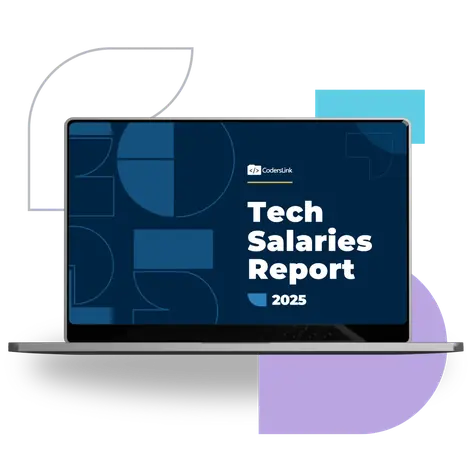
After years of working with startups and large enterprises hiring tech talent, we’ve seen that adopting a global mindset often opens up doors for companies in new and exciting ways. As remote work solidified its place in the new work paradigm, this perspective continues to have a lot of merit.
As a talent solutions partner, CodersLink knows firsthand that a vibrant talent pool extends far beyond U.S. borders and can offer a unique solution to a company’s need for specialized tech talent.
In our time working with Mexico’s top technical professionals, we’ve made a lot of meaningful connections between companies in a critical time of their development and tech professionals eager to advance and improve their careers with the right opportunity.
We’ve seen companies that find themselves in a difficult position: they are in a place ripe for growth, but find it difficult to balance the sourcing, recruitment, and hiring of a whole new team while managing and retaining their current teams. Their concerns are the following:
- Balancing the Hiring of New Teams and Company Expansion
- Ensuring Talent Retention Among New Hires and Older Team Members
Let’s dive into how global mindsets can make a difference.
What Does a Global Mindset Refer To?
From our perspective, a global mindset means embracing the idea of hiring across borders as a way to grow, expand, and enhance teams. Building remote tech teams is likely to become more ubiquitous. Whether your team is spread out across the U.S. or goes into different countries, the concept of functional and effective geographically dispersed teams is seen more favorably today than it was just a few years ago. In fact, it has served as a solution for many companies looking for ways to expand.
Adopting a Global Mindset as Your Company Expands: A Case Study
Nearshoring to Latin America has offered companies a way to break into new markets without going across the globe.
Q2, for example, is a Texas-based financial firm that provides digital banking services and integration. The company found itself in a position where it wanted to expand but was unsure how to go about it without sacrificing company stability or momentum.
By working with an expert in Mexico’s IT labor market, they were able to break into LATAM’s largest tech hub and open up an office a few hours from their headquarters in Texas. CodersLink helped Q2 build their office from the ground up using high-caliber talent in the region.
This Wall Street Journal article explains Q2s trajectory and how CodersLink helped play a role in the facilitation of that process.
Another Success Story in Building Teams Across Borders
A few years ago, CodersLink worked with NetProtect, a global leader in internet protection. The company already had offices in Asia but was experiencing issues with their team. These issues—including time zone differences— were affecting their project delivery.
They wanted to transition into an outsourced team closer to their headquarters and scale their needs effectively.
They looked to Mexico as an option because of its proximity to the U.S. and its well-regarded talent pool. The partnership with CodersLink allowed them to make that transition, continue their growth and expansion, and provide support so they could continue managing without causing internal chaos to their core teams.
Addressing The Talent Gap Dilemma with a Global Mindset
The tech industry experienced a whirlwind of change between 2019 and 2022. As we look back, the research and the evidence on the ground suggests that, despite some hiccups, the need for qualified tech talent in a wide variety of capacities and industries continues to grow.
It’s not only tech companies that need software developers and engineers but companies in other sectors that seek digital transformation and improvement of their digital infrastructure to compete with today’s changing demands.
The problem, however, that many companies are running into is finding the talent they need with the right skills. And, despite the hype, there is still a long way to go before robots or AI eradicate the need for human talent and creativity.
An oft-repeated statistic in the labor discussion is that by 2030, there will be a global human talent shortage of more than 85 million people. This number comes from a Korn Ferry country-by-country analysis. It paints an interesting picture of the labor workforce and is pointing companies into considering the way they approach their growth and hiring.
A Possible Solution to Talent Gap Issues
Companies need to adapt their mindsets and think about building teams in a different way. Here are the approaches:
- By tapping into new markets, employers open up opportunities offered by building diverse remote tech teams.
- For companies that want to expand their operations, opening up an office in a new location can be the first step towards a long-term growth strategy.
- Leveraging local resources to ensure talent sourcing and recruiting is done effectively and ethically.
- Recruiting today demands a much more personalized approach.
- Finding a local partner familiar with the local talent market ensures that companies take full advantage of the unique aspects of each talent market and can reap all the benefits.
- Using smart recruiting focused on emphasizing skills and future learning potential.
- Focus on finding talent that exhibits a potential and propensity for learning and adaptability.
- Today, digital talent values career development and personal growth. By finding candidates that align with your company culture will increase the chances of successful placements and long-term commitments.
Addressing The Talent Retention Dilemma with a Global Mindset
Of course, once companies hire specialized talent there is no guarantee that they’ll stick around. Recent McKinsey Global Institute research suggests that tech workers change roles every 2.7 years. In larger tech companies, this rate looks closer to 1-2 years. So how do companies mitigate the very real problem of high attrition rates and high turnover rates?
We’ve seen companies struggling to juggle the balance between hiring new teams while losing some of their workers to competing companies.
So, how does a global mindset come into play here?
What’s important is that companies recognize what workers are looking for and can understand the local market in a profound way.
The Solution to a High Attrition Rates in Tech
Take a skills-based approach to talent management.
What does that mean?
Taking a skills-based approach means your company emphasizes hiring people that show potential for learning, improvement, and adaptability. This, in combination with important soft skills, is more likely to yield favorable results in the long haul.
You can find the right people by working with someone that understands the talent pool from which you hire. Moving into a new talent market with no guidance or advice can be very overwhelming. So, as you look for talent in new countries and regions; What is today’s talent looking for?
Evidence suggests that tech talent in particular sees career advancement and learning opportunities as a major driver and inspiration to stay in their current role. So, if you’re worried about losing talent to larger companies offering higher salaries, find ways to offer career advancement, training, or learning opportunities that make your company that much more attractive.
Recent data from McKinsey shows just how much career development matters to people. The ranking factors driving U.S. digital workers’ attrition and retention looks a little like this:
Top factors (in order of importance):
- Career development and advancement potential
- Workplace flexibility
- Meaningful work
- Compensation and financial-related factors
Great Talent is Everywhere, It’s Just About Knowing How to Find It
Great talent is not restricted by borders. Technology has become a global language and countries throughout the world are adopting it as a way to move their societies forward and find solutions to common problems.
Need a next-generation growth strategy? Think global. Think Latin America and its potential. Learn more with CodersLink.


